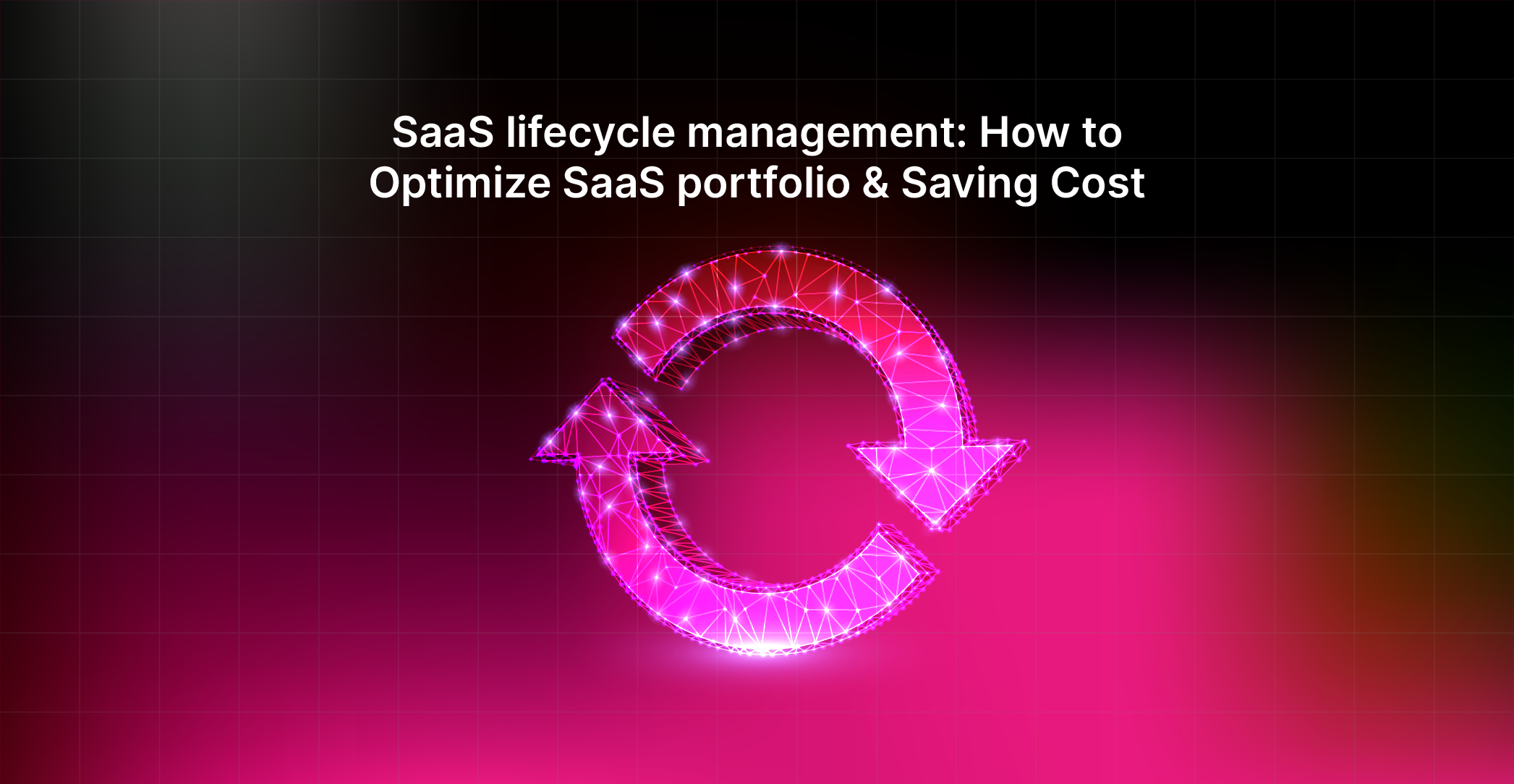

A Complete Guide On SaaS Lifecycle Management In 2025 (+ Case Study)

A Complete Guide On SaaS Lifecycle Management In 2025 (+ Case Study)
The SaaS lifecycle involves evaluating the company’s SaaS needs, finding the best vendors at the right price, managing and tracking vendor performance


Businesses are rapidly adopting SaaS solutions to facilitate various functions. The SaaS market is growing rapidly and is expected to be worth $232 billion by 2025.
These statistics are backed by market research data that suggest that SaaS spending will grow at 15%-20% annually. The same report states that companies are investing in an average of 125 different SaaS applications and spending $1,040 per employee.
Gartner forecasts that annual SaaS expenditure will grow by more than 19%, yet 25% of SaaS tools will be underutilized or overdeployed. SaaS lifecycle management will help gain visibility and prevent overspending.
Through SaaS lifecycle management, we’ll explain how to reap benefits such as increased data security, reduced SaaS wastage, greater internal order, and increased ROI and savings.

What is SaaS lifecycle management?
SaaS lifecycle management is the process of optimizing and managing SaaS applications from its introduction into the company until its retirement.
With a well-structured process, the company can establish benchmarks for adopting and using SaaS tools. It also helps put in place best practices for the SaaS vendor life cycle, portfolio management, and data security.
The SaaS life cycle involves the following:
- Evaluating the organization's SaaS needs
- Selecting the most relevant vendors to fill those needs at the best price
- Managing and tracking vendor performance
- Renewing or offboarding vendors per the organization's needs.
Here are the stages of the SaaS lifecycle:
1. Evaluating the organization's SaaS needs
First, understand why you need a SaaS solution and what its objective is.
Next, the question is how to find a solution.
With an audit of your SaaS portfolio, you can assess the capabilities of existing applications. If the portfolio needs an upgrade, you can lay out a SaaS evaluation framework and choose the best vendor solution.
2. Reviewing and selecting vendors
Select a suitable vendor, keeping a few factors in mind that make SaaS lifecycle management all the more effective.
- Find out whether the prospective SaaS vendor is compliant with all your data security needs.
- Gauge how challenging it will be to adopt a new company-wide solution.
- Since companies have people comfortable with different levels of technology usage, choose a simple tool that has an intuitive interface.
- A dedicated customer support team is a must while selecting the right vendor for your company's needs.
3. Price negotiation and approvals
You won't find many advertisements about discounts on SaaS tools because service providers do not promote the fact that they have room to negotiate SaaS contracts.
However, they use maneuvers such as price transparency on their websites to let buyers believe they are availing a great deal.
There is ample scope to bring down prices and also negotiate on other contract terms such as warranties, support services, software scalability, security, and defining service level agreements.
At this stage, analyze whether there are additional hidden costs involved, whether users can try the tool before an agreement is signed and if the solution is scalable.
Pro tip: A SaaS procurement tool backed by a team of buying experts can save you the hassle of negotiation with vendors and guarantees returns on your spend.
4. Onboarding the vendor
Build an onboarding plan for your approved vendors by:
- mapping out ownership details of the SaaS tool and stakeholder roles,
- defining renewals and evaluation dates, and
- setting out objectives and benchmarks.
All of these steps measure the impact of the SaaS tool within the organization.
At this stage, you also communicate your company's goals, timelines, and internal processes to the vendor and learn more deeply about their processes.
After charting out the plan, the practical implementation begins. You decide which team will use the tool and align your IT team to implement it. You also have to take your team through the nitty-gritty of using that tool efficiently, providing them with tutorials, videos, and documentation. The more thorough their foundations, the better.
An important message to send to your team is to welcome the change. Replacing outdated technologies can be challenging and the management must ensure the team adapts well.
5. Tracking and managing applications
At this stage, you monitor the vendor’s performance in an ongoing manner and gauge whether the application is hitting the right objectives set out for it.
Tracking helps you decide whether to continue using the application.
Holistic SaaS tool management involves:
- Documenting vendor details
- Tracking usage
- Handling contracts
- Holding periodic vendor reviews
- Fostering healthy communication with SaaS vendors.
You must identify essential business activities conducted on the SaaS application and map its end-user experience.
Identifying the KPIs for those functions and monitoring the SaaS tool’s performance against them will help you prepare for the next step: renewing and offboarding vendors.
6. Renewals and offboarding vendors
The final stage of the SaaS application lifecycle involves deciding whether to renew or retire the SaaS contract.
The objectives of this stage are to:
- Minimize SaaS wastage
- Address employee feedback and needs
- Reduce SaaS spending
- Optimize business functions.
In case of vendor offboarding, the exit should be safe, compliant, and cost-effective. Key concerns include:
- Preserving data
- Ensuring data security during and after vendor offboarding
- Preparing the team for the technological transition.
In case of contract renewal, you should be aware of renewal dates and prepared to renegotiate contract agreements based on user sentiment data.
Overall, SaaS lifecycle management right sizes SaaS costs, reduces data-related risks, and increases visibility into the company’s SaaS portfolio.
Recommended Read: Complete guide to SaaS spend management
Importance effective SaaS lifecycle management
From selecting the right vendor to renewing or retiring contracts, each stage of the lifecycle presents unique challenges and opportunities.
But one objective is certain—to help companies contain costs, reduce risks, and optimize their SaaS portfolio.
1. Reducing security risks
Companies are grappling with the trade-off between the convenience of SaaS tools and the loss of control over data, security, and application management.
SaaS customers face a range of threats, including data loss, unauthorized access, and shadow IT.
To address these challenges, companies must adopt effective SaaS lifecycle management practices, which include:
- Selecting the right vendor
- Enforcing stringent data protection standards
- Closely monitoring vendor performance to minimize risks, and
- Safeguarding data.
2. Increased visibility into the SaaS portfolio
By closely monitoring their SaaS portfolio, companies can prioritize their security, data protection, governance, and management needs.
Increased visibility means having a comprehensive understanding of all existing SaaS tools, their usage within teams, and potential cybersecurity risks.
Effective SaaS lifecycle management is key to achieving this level of insight, helping companies save costs and mitigate risks while maximizing the benefits of their SaaS tools.
3. Saving money and resources
When you look closely into your SaaS portfolio, you will discover areas where tools are underutilized or licenses are wasted.
For instance,
- teams signing up for the same application separately
- overlap between functionalities of tools.
Companies can increase their ROI and reduce redundant SaaS expenses by eradicating duplicate applications and making the most of volume pricing discounts.
Furthermore, it helps optimize resources by simplifying their administration, streamlining SaaS usage, and enhancing IT efficiency.
4. Saving time by automating process
By automating each step of the SaaS lifecycle management process from vendor onboarding to mid-cycle changes and offboarding, companies can save time and reduce the risk of human error.
SaaS management platforms (SMPs) centralize SaaS management and free up valuable team resources.
They offer a range of automation capabilities, including mapping and selecting SaaS vendors, tracking company-wide usage, estimating costs, and managing vendor onboarding and offboarding.
For example, procurement automation can streamline routine tasks such as contract processing, invoice processing, payment processing, and supplier selection.
Case Study: Wodify
Wodify, a gym and studio management software, automated their SaaS buying and saved time, resources, and costs. Before opting for Spendflo’s SaaS solutions, they struggled to track the usage of their SaaS stack in one place and gather overall insights.
Automating their buying and management allowed Wodify to customize each SaaS contract per their needs and set the latest pricing benchmark to get winning deals for their SaaS stack.
Automate your SaaS lifecycle with Spendflo to maximize your returns
Spendflo helps businesses save time and costs on their SaaS contracts.
You can automate your SaaS lifecycle with Spendflo and reap the benefits of efficiently managing each step in the SaaS lifecycle from procurement automation to managing contracts and tracking usage to handling renewals.
In this process, we help you gain complete visibility into your SaaS stack and cut needless SaaS spending.
Sign up for your free analysis today.













.png)




%20Questions%20to%20Ask%20Vendors.webp)





.avif)





